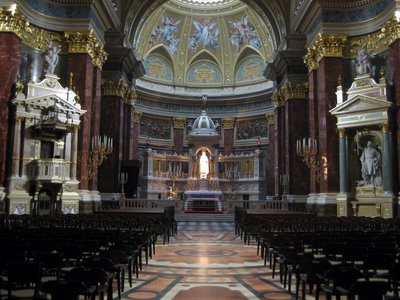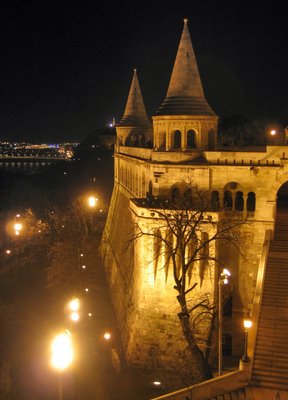Budapest, Hungary (2/4)
Thinking I had arrived at Bratislava’s train station a half hour early for the 11:51 train to Budapest, I confidently approached the ticket window and said, “Jeden listek do Budapešt, prosím.” An exasperated expression passed across the woman’s face and she typed furiously at her keyboard. Sighing, she wrote 4:54 on a piece of paper and spun it towards me. Apparently I hadn’t fooled her into thinking I was Czech. My eyebrows furled. She then wrote 11:51 and crossed it out. “OK,” I said disappointedly.* I studied the ticket as I walked away from the counter wondering how the 11:51 train had managed to fill up. It wasn’t exactly tourist season. Then I noticed something strange. The upper right corner of the ticket read “12:18.” I looked at my watch: 11:18. ‘Oops. Hello, spring.’**
My extra time in Bratislava was spent reading Hašek’s The Good Soldier Švejk, eating a chicken kebab, and striking up a conversation with a Slovakian girl who resembled Kirsten Dunst. During the evening train ride to Budapest I met a second Slovakian girl who was equally as beautiful. Inductive reasoning has me convinced that Slovakia is, in fact, full of the most beautiful women in the world.
I arrived at the Marco Polo Hostel without a florin to my name, intending to find a bankomat on my way to dinner.*** The curt receptionist explained that I could pay later but they would need a deposit for the key. “Dollars? Euros?” she said with raised eyebrows. I cocked my head to the side and replied, “Um… how about Slovak crowns?” I felt simultaneously unprepared and worldly. She glared at me and reluctantly accepted the crowns.
The hostel resembled an empty hotel, and, after locking up my backpack, I left in search of dinner. The broken streets were emptier than the hostel. Golden light washed over the dirty, shambled buildings. Cracks covered the façades and revealed glimpses of buildings’ frames. After wandering for nearly a mile I found a bankomat and a restaurant with Hungarian food. The food was colored deep red with paprika but was frankly nothing to write home (or to blog readers) about. Eating alone was the only part of traveling solo that felt truly awkward. Dinners are a time for conversation and I had none. I easily kept myself entertained with guidebooks, but I always felt empty in restaurants despite the food that was filling me.
************************
I began Monday’s touring with St. Stephen’s Basilica and a tour of the parliament building, which was the most amazing secular building I have ever seen. Both buildings left me aching for my broken camera, but my photos came out without it.
St. Stephen’s Basilica:


 Parliament:
Parliament:


 From parliament, I rode the oldest metro line in Europe to the Széchenyi baths. A baroque, yellow building surrounded the complex of pools. I descended down the steps into the warm water and weightlessly danced over to the chess board. 5 old men and myself slowly bobbed up and down, intently watching the game unfold. The dazzling moves made it clear that these men had not spent their childhoods playing Nintendo. Chess was engrained in the old men like the wrinkles on their faces. Intimidated, I resigned myself to the position of spectator.
From parliament, I rode the oldest metro line in Europe to the Széchenyi baths. A baroque, yellow building surrounded the complex of pools. I descended down the steps into the warm water and weightlessly danced over to the chess board. 5 old men and myself slowly bobbed up and down, intently watching the game unfold. The dazzling moves made it clear that these men had not spent their childhoods playing Nintendo. Chess was engrained in the old men like the wrinkles on their faces. Intimidated, I resigned myself to the position of spectator. That evening I hiked up to the castle. The majestic Matthias church was closed, but I made up my mind that I would make it inside one way or another before leaving Budapest. As the sky darkened above Budapest Castle, I explored the labyrinth underneath it by lantern. The labyrinth had a Disneyland feel to it; it was not the real deal. On the other hand, Disneyland wouldn’t thrust its visitors into a pitch black cavern with a flame and a map…
That evening I hiked up to the castle. The majestic Matthias church was closed, but I made up my mind that I would make it inside one way or another before leaving Budapest. As the sky darkened above Budapest Castle, I explored the labyrinth underneath it by lantern. The labyrinth had a Disneyland feel to it; it was not the real deal. On the other hand, Disneyland wouldn’t thrust its visitors into a pitch black cavern with a flame and a map…
 Monday left me missing my family. A temperate breeze flowed through Budapest like the breezes that course over Hawaii’s shores in the evening. Wading in the baths reminded me of swimming with my family. The labyrinth was something they might have enjoyed. I ate at Burger King on the way back to the hostel, which reminded me of the times we grab fast food on the way to Wisconsin.
Monday left me missing my family. A temperate breeze flowed through Budapest like the breezes that course over Hawaii’s shores in the evening. Wading in the baths reminded me of swimming with my family. The labyrinth was something they might have enjoyed. I ate at Burger King on the way back to the hostel, which reminded me of the times we grab fast food on the way to Wisconsin.
************************
I ascended the antique metro’s steps to the powerful Hero’s Square. Frankly there are countless monuments in Europe, and I had become somewhat jaded, cynically expecting another man on a horse. Budapest’s Hero’s Square was no ordinary monument. It had a tremendous presence. The central winged figure commanded the square with untouchable force.

 From the square I entered the Museum of Fine Arts to discover a free English tour starting in 10 minutes. The tour was fabulous and it increased my appreciation of the symbolism in gothic paintings and the hidden messages in baroque paintings.
From the square I entered the Museum of Fine Arts to discover a free English tour starting in 10 minutes. The tour was fabulous and it increased my appreciation of the symbolism in gothic paintings and the hidden messages in baroque paintings.
My next destination was the House of Terror, but I sent myself on a wild goose chase when I confused the Vörösmarty Tér metro stop for the Vörösmarty U. metro stop. The mistake turned out to be a blessing: I happened upon the Budapest Spring Festival. I floated past the booths of “authentic” Hungarian crafts imported from China when I spotted a man whittling flutes in the recess of his small wooden shack. This was what I had been waiting for: an old man with some wood and a knife (even if his products suggested this little old man had a very nice shop someplace). Some of his whistles had two tubes so that the user could play one melody on top of a bass note. This was simply too much to resist. I bought one and slipped it inside of my fleece coat where the pocket was sewn. I may have been a tourist but I certainly didn’t have to look like one by carrying plastic bags all over. I eventually did find the House of Terror, which was a high tech amalgamation of Nazi and Soviet displays.
Tuesday night was the highlight of my entire spring break. I had nabbed a pamphlet at the spring festival and I scanned the night’s events. The Saint Ephraim Byzantine Men’s Choir was performing at none other than Matthias Church—the very church that had been closed the evening before. I showed up an hour early and sat in the very center of the second row. I passed the time by talking to a German man next to me. The church reminded me of St. Mary’s in Kraków. Every inch was covered in paint and it looked spectacular. Ancient Hungarian flags hung from the ceiling, adding regality to the place of worship. The choir, clad in colored robes with thick gold trip entered, and the eastern cousin of Gregorian chant filled the cathedral. The bass added a power to the choir’s sound that reverberated off the arched walls. The concert was amazing.
 I exited the church into the cool night breeze and pulled the camera out of my pocket for some night shots of Budapest.
I exited the church into the cool night breeze and pulled the camera out of my pocket for some night shots of Budapest.




 The fabulous concert had left me in a pleasant mood, interrupted only by tinges of anxiety concerning the local, one hundred percent Hungarian train to Eger the following morning.
The fabulous concert had left me in a pleasant mood, interrupted only by tinges of anxiety concerning the local, one hundred percent Hungarian train to Eger the following morning.
* “OK” is actually legitimate Czech. So is “Sorry.”
** In Europe daylight savings time occurs one week earlier than in the US.
*** ATMs are referred to as bankomats in Central Europe.
<< Home